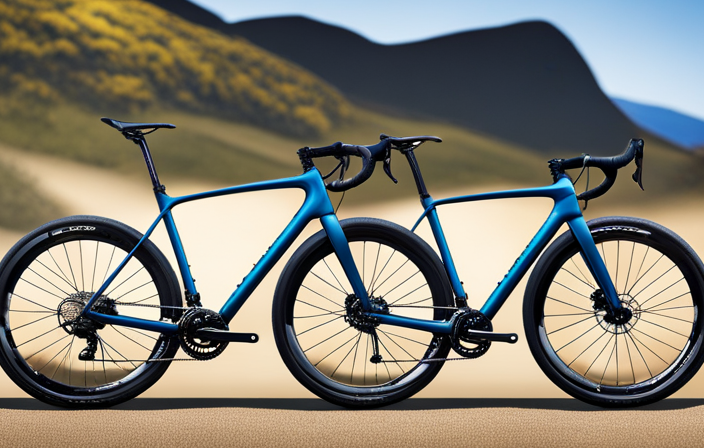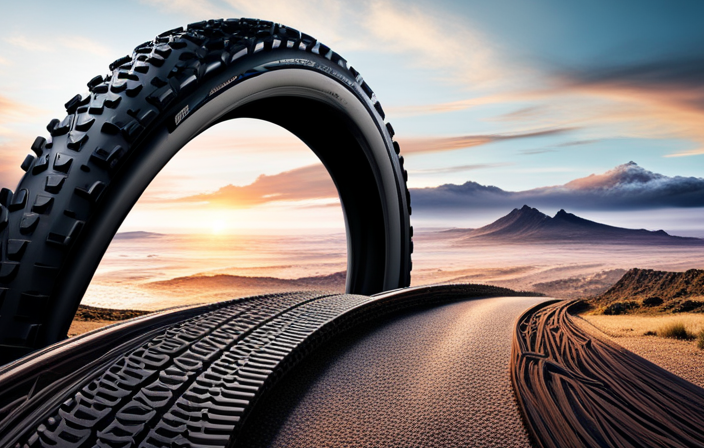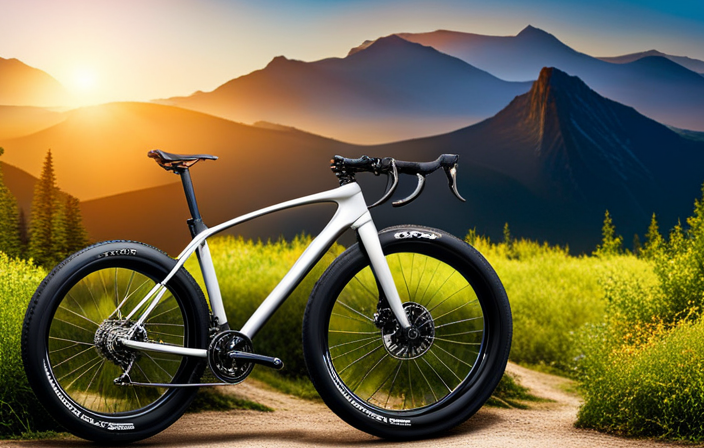While riding my gravel bike through rough terrains, I frequently search for the ideal gear arrangement that provides a balance of efficiency and versatility.
Enter the Shimano 1x setup – a game-changer in the world of gravel biking. This innovative system, known for its simplicity and reliability, eliminates the need for a front derailleur, providing a seamless experience on any terrain.
In this article, we will delve into the intricacies of the Shimano 1x setup, exploring its benefits, functionality, and how it can enhance your gravel bike adventures.
Key Takeaways
- The Shimano 1x setup simplifies the bike’s drivetrain and reduces weight, making it easier to navigate technical terrain on a gravel bike.
- The absence of a front derailleur eliminates chain drop and reduces mechanical complexity, enhancing the practical application of the Shimano 1x setup on gravel bikes.
- The clutch mechanism in the rear derailleur improves chain retention, reduces chain slap and noise, and provides flexibility to fine-tune the gravel bike’s performance with different chainring sizes.
- The simplified shifting process and availability of different gear ratios in the Shimano 1x setup offer lighter weight, increased clearance, and personalized riding options for faster and more efficient riding on mixed surfaces.
Introduction to the Shimano 1x Setup
You’ll love the simplicity and efficiency of the Shimano 1x setup for your gravel bike. The advantages of the Shimano 1x setup for off-road riding are numerous.
Firstly, it eliminates the need for a front derailleur, simplifying your bike’s drivetrain and reducing weight. With only one chainring up front, there are no worries about shifting between multiple gears, making it easier to navigate technical terrain.
Optimizing performance with the Shimano 1x system is crucial to fully enjoy its benefits. One tip is to choose the appropriate chainring size based on your riding style and terrain. For hilly routes, a smaller chainring will provide better climbing ability while sacrificing top-end speed. Conversely, a larger chainring will give you more speed on flat sections but may make steep climbs more challenging.
Another important consideration is selecting an appropriate cassette range that complements your chosen chainring size. This ensures you have a wide enough gear range for both climbing and descending.
Understanding the benefits of a 1x gear system goes beyond just simplicity and efficiency. It grants you greater flexibility by allowing you to customize your gear ratios to match your riding preferences. Plus, fewer moving parts mean less chance of mechanical issues during rides.
Now let’s delve into how this setup can enhance your gravel biking experience even further by exploring the various advantages in detail.
Understanding the Benefits of a 1x Gear System
Understanding the benefits of a 1x gear system can greatly enhance your cycling experience. Whether you are mountain biking or road cycling, there are significant advantages to using a 1x drivetrain.
In mountain biking, the benefits of a 1x gear system include simplicity and improved chain retention. With only one front chainring, shifting becomes easier and more intuitive, allowing you to focus on the trail ahead. The absence of a front derailleur also reduces weight and eliminates the risk of dropped chains, ensuring reliable performance in rough terrain.
For road cycling, the advantages of a 1x drivetrain lie in its efficiency and versatility. With advancements in cassette technology, wide-range cassettes now offer enough gears to tackle any gradient without sacrificing speed or cadence options. This means that you can conquer steep climbs while still maintaining high speeds on flat roads. Additionally, a 1x setup reduces mechanical complexity by eliminating the need for multiple chainrings and front derailleurs.
Transitioning into the subsequent section about how the Shimano 1x setup works, it is important to understand how these benefits translate into practical application on your gravel bike.
How the Shimano 1x Setup Works
The Shimano 1x setup simplifies gear shifting and improves chain retention for a more efficient cycling experience. When it comes to gravel riding, there are several advantages of using a 1x setup.
Firstly, the absence of a front derailleur reduces weight and eliminates the risk of chain drop in rough terrain. Additionally, having only one chainring allows for easier maintenance as there are fewer components to clean and adjust.
Now let’s compare the Shimano 1x setup with those from other brands. One notable competitor is SRAM, which offers their own 1x drivetrain called X-Sync. Both Shimano and SRAM provide excellent performance and reliability, but they have some differences worth noting.
For example, Shimano’s system utilizes a clutch mechanism in the rear derailleur known as Shadow Plus, which helps reduce chain slap and noise on bumpy roads.
In conclusion, the Shimano 1x setup offers numerous advantages for gravel riding compared to traditional multi-chainring setups. It simplifies gear shifting by eliminating the need for front derailleurs while improving chain retention in rough conditions. This makes it an ideal choice for riders who value simplicity, efficiency, and reliability on mixed surfaces.
Now let’s delve into how this setup achieves improved chain retention and reduced chain drops without compromising performance or versatility.
Improved Chain Retention and Reduced Chain Drops
To achieve improved chain retention and reduce chain drops, you’ll notice a clutch mechanism in the rear derailleur that effectively minimizes chain slap and noise on rough roads. This feature is designed to keep the chain taut, preventing it from bouncing around and potentially falling off the chainring. The clutch engages when the derailleur is in use, creating tension that keeps the chain secure even on bumpy terrain.
The first sub-list highlights the benefits of improved chain retention:
- Enhanced confidence while riding over technical sections
- Reduced risk of dropping the chain during critical moments
The second sub-list emphasizes compatibility with different chainring sizes:
- Allows for more versatile gearing options based on personal preference
- Provides flexibility to fine-tune your gravel bike’s performance
With this improved shifting performance, riders can trust their Shimano 1x setup to deliver consistent gear changes even under demanding conditions. Additionally, the system’s compatibility with different chainring sizes allows riders to tailor their gear ratios to their specific needs.
Moving forward into our discussion about simplified shifting and gear range, it becomes evident how these advancements enhance overall gravel riding experience without compromising efficiency or control.
Simplified Shifting and Gear Range
With simplified shifting and a wide gear range, I can easily navigate varying terrains on my Shimano 1x equipped bike. The beauty of the 1x setup lies in its ability to provide a simple and efficient shifting experience. Gone are the days of worrying about front derailleur adjustments or chain rub. The single chainring up front eliminates the need for multiple chainrings and simplifies the shifting process.
Shimano offers different gear ratios for their 1x drivetrains, allowing riders to choose the perfect combination for their riding style and terrain. Whether I’m climbing steep hills or cruising on flat roads, I can find a gear that suits my needs. This versatility ensures a smooth and enjoyable riding experience.
Another advantage of the Shimano 1x setup is its compatibility with different drivetrains. It works seamlessly with both mechanical and electronic systems, giving riders plenty of options when it comes to choosing components.
With simplified shifting, a wide gear range, and compatibility with various drivetrains, the Shimano 1x setup provides an exceptional riding experience. But that’s not all; this system also offers lighter weight and increased clearance, which we will explore further in the next section.
Lighter Weight and Increased Clearance
One of the advantages of the Shimano 1x setup is its lighter weight, which allows for faster and more efficient riding. When it comes to gravel biking, having a lighter bike can make a significant difference in performance. The Shimano 1x drivetrain eliminates the need for a front derailleur and extra chainrings, reducing the overall weight of the bike.
In addition to being lighter, the Shimano 1x setup also provides increased tire clearance. This means that you can run wider tires on your gravel bike without worrying about them rubbing against the frame or fork. With increased tire clearance, you have more options when it comes to choosing tire sizes for different terrains, allowing for better control and traction off-road.
The benefits of using a 1x drivetrain for off-road riding are numerous. Here are four key advantages:
- Simplified shifting: With only one chainring and rear cassette, shifting becomes easier and more intuitive.
- Improved chain retention: The narrow-wide tooth profile on the chainring helps keep the chain securely in place even over rough terrain.
- Reduced maintenance: Without a front derailleur to adjust or cables to replace, maintenance becomes simpler and less time-consuming.
- Better ground clearance: The absence of a front derailleur creates more space between the bottom bracket and the ground, reducing the risk of hitting obstacles.
With these benefits in mind, it’s important to choose the right gear ratios for your riding style.
[Transition into subsequent section about ‘choosing the right gear ratios for your riding style’].Choosing the Right Gear Ratios for Your Riding Style
When choosing gear ratios for your riding style, it’s important to consider factors such as terrain, fitness level, and personal preference. Gear selection plays a crucial role in optimizing your performance on the bike and ensuring a smooth and efficient ride. One of the key benefits of a Shimano 1x setup for a gravel bike is the ability to choose the right gear ratios that suit your specific needs.
To help you understand how gear ratios work, let’s take a look at a table that depicts different combinations of chainrings and cassettes:
| Chainring (Front) | Cassette (Rear) | Gear Ratio |
|---|---|---|
| 38T | 11-32 | 3.45 |
| 40T | 11-34 | 3.64 |
| 42T | 11-36 | 3.86 |
As you can see from the table, each combination offers a unique gear ratio that affects your climbing techniques and overall performance. Lower gear ratios provide easier uphill climbing capabilities, while higher gear ratios are better suited for flat or downhill sections where speed is desired.
Understanding your riding style and preferences will help you select the ideal gear ratio range. Experimenting with different combinations can also lead to finding the perfect balance between efficiency and comfort on various terrains.
With an understanding of gear selection and climbing techniques established, it becomes evident why upgrading your gravel bike to a Shimano 1x setup can greatly enhance your riding experience without compromising performance in any way.
Upgrading Your Gravel Bike to a Shimano 1x Setup
To upgrade your gravel bike, consider switching to a Shimano 1x setup for improved performance and versatility. When it comes to off-road riding, optimizing gear ratios is crucial. With a 1x setup, you can customize your gear range to suit your specific needs and terrain. This means you can have a wider range of gears at the rear cassette without the complexity of front chainrings.
One of the main advantages of a 1x setup for gravel bikes is simplicity. Without a front derailleur, there are fewer components to worry about and maintain. This reduces the risk of mechanical issues and simplifies shifting, making it more reliable in rough conditions. Additionally, with only one chainring in the front, there is less chance of dropping chains or chain suck.
However, there are some trade-offs to consider. With fewer gears at the front, you may experience larger jumps between gears compared to a traditional 2x setup. This can make it harder to find that perfect cadence on certain terrains. Also, if you’re used to having very high or low gearing options for extreme climbs or descents, a 1x setup may not provide as wide of a gear range.
In conclusion, upgrading your gravel bike to a Shimano 1x setup offers improved performance and versatility by optimizing gear ratios for off-road riding while providing simplicity and reliability. In the next section, we will discuss maintenance and care tips for the Shimano 1x system.
Maintenance and Care Tips for the Shimano 1x System
Maintaining and caring for the Shimano 1x system is essential for optimal performance and longevity. Here are some important maintenance tips to keep your Shimano 1x system running smoothly:
-
Regularly clean and lubricate the chain: Use a degreaser to remove dirt and grime from the chain, then apply a high-quality lubricant. This will help reduce friction and extend the life of your drivetrain.
-
Check for wear on the cassette and chainring: Over time, these components can become worn down, affecting shifting performance. Inspect them regularly and replace if necessary.
-
Adjust the derailleur alignment: A misaligned derailleur can cause poor shifting or even damage to your drivetrain. Use a screwdriver or Allen wrench to make small adjustments until the shifting is smooth and precise.
-
Replace cables and housing when needed: Frayed or corroded cables can lead to unreliable shifting. Inspect them regularly, looking for signs of wear, and replace as necessary.
By following these care tips, you can ensure that your Shimano 1x system performs at its best for years to come.
In the next section, we will compare the Shimano 1x setup to other gear systems.
Comparing the Shimano 1x Setup to Other Gear Systems
If you’re considering different gear systems, comparing the Shimano 1x setup to others can help you make an informed decision. The Shimano 1x setup offers several advantages over traditional gear systems, such as the 2x gear system.
One of the main advantages is simplicity. With a single front chainring and a wide-range cassette in the rear, there are fewer components to worry about and maintain. This means less time spent on maintenance and more time enjoying your ride.
Another advantage of the Shimano 1x setup is improved chain retention. The narrow-wide chainring design helps keep the chain in place even on rough terrain, reducing the risk of dropping your chain while riding. Additionally, the absence of a front derailleur eliminates any shifting issues that may occur with a traditional 2x system.
The wider gear range offered by the Shimano 1x setup is also worth mentioning. With larger cassette options available, you can still have a wide range of gears for tackling both steep climbs and fast descents.
In conclusion, when comparing the Shimano 1x setup to other gear systems like the 2x system, it becomes clear that there are significant advantages to choosing the 1x setup. It offers simplicity, improved chain retention, and a wider gear range for all types of riding conditions.
Now let’s move on to learn some tips for properly adjusting and tuning your Shimano 1x setup without missing a beat.
Tips for Properly Adjusting and Tuning Your Shimano 1x Setup
For proper adjustment and tuning of your Shimano 1x setup, make sure to follow these helpful tips.
First and foremost, it is crucial to ensure proper chain tension. This can be achieved by adjusting the position of the rear derailleur. Begin by shifting the chain onto the smallest cog at the back and then loosen the mounting bolt that holds the derailleur in place. Gently push or pull the derailleur until there is slight tension on the chain. Once you have achieved this, tighten the mounting bolt securely.
Next, it is important to check and adjust derailleur alignment. Misalignment can lead to poor shifting performance and potential damage to your drivetrain. Start by visually inspecting if the upper jockey wheel aligns perfectly with each cog on your cassette. If not, use a 5mm Allen wrench to make small adjustments until proper alignment is achieved.
By following these steps, you can ensure that your Shimano 1x setup operates smoothly and efficiently on your gravel bike.
Now let’s move on to common issues and troubleshooting for the Shimano 1x system without writing ‘step’.
Common Issues and Troubleshooting for the Shimano 1x System
Let’s now address some common issues and troubleshooting tips for the Shimano 1x system.
One of the most common issues with this setup is chain drops. If you find that your chain is dropping off the front chainring, there are a few things you can check and adjust.
First, make sure that your chainring is properly aligned and not bent or warped. A misaligned chainring can cause the chain to drop.
Additionally, check the tension of your clutch on the rear derailleur. If it’s too loose, it may not provide enough tension to keep the chain in place.
Another issue that riders may encounter with their Shimano 1x setup is improper shifting or difficulty shifting between gears. In this case, adjusting the front derailleur may be necessary.
Start by checking if the derailleur is properly aligned with the chainring teeth. It should be parallel to them without touching or rubbing against them during operation.
If it needs adjustment, use a hex key to loosen the bolts holding it in place and carefully align it before tightening again.
By troubleshooting these common issues like chain drops and adjusting front derailleurs, you can ensure optimal performance from your Shimano 1x system.
Now let’s move on to riding techniques and tips for getting the most out of your Shimano 1x setup without skipping a beat!
Riding Techniques and Tips for Getting the Most Out of Your Shimano 1x Setup
Improve your riding experience with the Shimano 1x system by mastering these essential techniques and tips. Here are three riding techniques that will help you optimize performance with your Shimano 1x setup:
-
Cadence Control: Maintaining a consistent cadence is crucial for getting the most out of your 1x system. By finding the right gear ratio and adjusting your pedaling speed, you can maximize power transfer and efficiency. Experiment with different cadences to find what works best for you.
-
Shifting Technique: With only one front chainring, shifting becomes even more important. Practice smooth and precise shifts to avoid any loss of momentum or chain drops. Anticipate terrain changes and shift preemptively to stay in the optimal gear at all times.
-
Terrain Adaptation: The Shimano 1x system offers a wide range of gears, allowing you to tackle various terrains with ease. Learn how to anticipate changes in gradient or surface conditions and make quick adjustments to maintain an efficient pedal stroke.
By mastering these riding techniques, you can optimize the performance of your Shimano 1x setup and enhance your overall gravel biking experience.
In the next section, we will explore different terrain and riding styles that are well-suited for the versatility of the Shimano 1x system.
Exploring Different Terrain and Riding Styles with the Shimano 1x Setup
When it comes to riding techniques and tips for optimizing your Shimano 1x setup, I’ve covered a lot of ground. From cadence control to efficient shifting, we’ve explored the intricacies of getting the most out of this versatile drivetrain. Now, let’s delve into the exciting world of exploring different terrain and riding styles with the Shimano 1x setup.
One of the biggest advantages of the Shimano 1x system is its adaptability. With a wide range cassette and the option to customize your chainring size, you can easily tailor your gear ratios to suit your riding preferences and tackle various terrains. Whether you’re climbing steep gravel hills or sprinting along flat roads, finding that perfect gear ratio has never been easier.
Adapting to changing terrain becomes second nature with a Shimano 1x setup. Thanks to its simplicity and intuitive shifting, you can quickly respond to elevation changes or unexpected obstacles without missing a beat. The absence of a front derailleur eliminates any worries about dropped chains or finicky adjustments – just focus on enjoying your ride.
As we approach the conclusion: embracing the Shimano 1x setup for your gravel bike adventures, it’s important to understand how this drivetrain excels in providing seamless performance across diverse landscapes. So let’s dive in and discover why this system is truly a game-changer for gravel enthusiasts like myself.
Conclusion: Embracing the Shimano 1x Setup for Your Gravel Bike Adventures
Embracing the Shimano 1x system on your off-road adventures is a game-changer, providing seamless performance across diverse landscapes. With its simplicity and versatility, this setup offers endless possibilities for gravel bike enthusiasts like myself.
When it comes to upgrading options, the Shimano 1x system allows you to customize your drivetrain according to your specific needs. Whether you prefer tackling steep climbs or speeding through flat terrains, there are various cassette and chainring options available to optimize your gear ratios. This flexibility ensures that you have the perfect setup for any riding style or terrain.
Maintenance tips are essential when it comes to maximizing the lifespan of your Shimano 1x setup. Regularly cleaning and lubricating the chain is crucial to prevent dirt buildup and ensure smooth shifting performance. Additionally, inspecting the derailleur hanger alignment and adjusting cable tension can help maintain precise shifting accuracy.
To further enhance your riding experience, consider investing in a clutch-style rear derailleur. This feature reduces chain slap and provides increased chain retention over rough terrain, giving you more confidence during aggressive descents.
In conclusion, embracing the Shimano 1x setup opens up a world of possibilities for gravel bike adventures. With its customizable options and proper maintenance techniques, this system will undoubtedly elevate your off-road experiences. So gear up and get ready to explore new horizons with the reliable performance of Shimano’s 1x drivetrain!
Frequently Asked Questions
Can the Shimano 1x setup be used on any type of bike, or is it specifically designed for gravel bikes?
The Shimano 1x setup can indeed be used on various types of bikes, including road bikes. Its compatibility with road bikes allows for a simplified drivetrain and improved performance off-road.
The benefits of a 1x setup for off-road riding include reduced weight, increased chain retention, and easier shifting in challenging terrain. This makes it an ideal choice for riders seeking versatility and efficiency in their cycling experience, regardless of the bike type they choose.
Are there any specific tools or equipment required for installing a Shimano 1x setup on a gravel bike?
To install a Shimano 1x setup on a gravel bike, you will need specific tools and equipment. These include a bottom bracket tool, chain whip, cassette lockring tool, and a torque wrench. You may also need a chain breaker to size the chain correctly for your setup.
It is worth noting that the Shimano 1x setup is commonly used on gravel bikes. However, it can also be compatible with other types of bikes, such as mountain bikes or cyclocross bikes, with some minor adjustments.
How does the Shimano 1x setup compare to a traditional 2x or 3x gear system in terms of gear range?
The Shimano 1x setup offers a comparable gear range to traditional 2x or 3x systems, but with some distinct advantages and disadvantages.
In terms of gear range, the Shimano 1x system provides a wide range of gears suitable for various terrains. However, it may lack the extreme high or low gears that a 2x or 3x system can offer.
The advantage of the Shimano 1x setup is its simplicity and weight savings, as it eliminates the front derailleur and reduces complexity. However, riders may miss having smaller steps between gears that a multi-chainring system provides.
Is it possible to switch back to a multi-chainring setup after installing a Shimano 1x setup?
Switching back to a multi-chainring setup from a Shimano 1x setup is possible and depends on the compatibility of your bike frame. However, it may require additional components such as a front derailleur, shifter, and chainrings.
Keep in mind that these changes can affect the overall performance and shifting accuracy. Therefore, it is essential to consult with a professional mechanic or refer to Shimano’s technical documentation for specific instructions regarding compatibility with different bike types.
Are there any specific riding techniques or adjustments needed when using the Shimano 1x setup on different types of terrain?
When using the Shimano 1x setup on different terrains, it is important to adjust shifting techniques and optimize gear ratios.
For example, on steep climbs, I recommend staying in a lower gear to maintain traction and power.
On flat or rolling terrain, shifting to a higher gear will allow for faster speeds.
It’s crucial to become familiar with the gear ratios and practice shifting accordingly to ensure smooth and efficient riding on various terrains.
Conclusion
So there you have it, the Shimano 1x setup is a game-changer for gravel bike enthusiasts.
With its improved chain retention and simplified shifting, this system offers a smoother and more efficient riding experience.
While some may argue that having a wider gear range with multiple chainrings is more advantageous, the 1x setup eliminates the need for front shifting and reduces the risk of dropped chains.
So don’t let any doubts hold you back, embrace the Shimano 1x setup and enjoy your gravel adventures like never before!
















